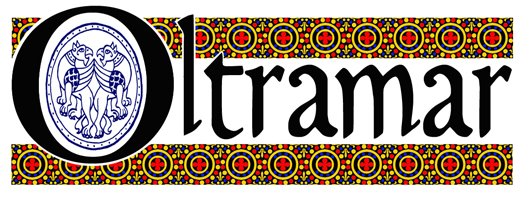I was first introduced to the concept of a magnum opus in the early 70s through an Asterix book ('The Roman Agent', and a big dumb character called Magnumopus) and needless to say this contributed to a) my misunderstanding of the term for quite a few years and b) my underlying feeling that a magnum opus is in some way a Big Dumb Thing, reinforced by my family joking about fairly important things they'd created; so a magna-mopus became (for us) a thing that was really quite special and you'd spent a lot of time on but didn't want to blow your own trumpet so belittled it by calling it such.
I find that I create one of those bite-off-more-than-you-can-chew projects about once a year and for a month or two or four focus on it fairly exclusively - I think 'obsessive' is *such* a strong term, but I really don't get much else done LOL.
You may have noticed from earlier posts that I have an altar set up in my tent (appropriate to a noblewoman - one has to have a *place* to say one's devotionals 😉) The silk mat on the altar, which I got 2nd (?) hand in the 1990s, perished and needed replacing... so I launched into a Major Project.
There are quite a few examples of beaded textiles from our period, mostly Sicilian and German (which were influential in Cyprus at that time due to the interference of the Holy Roman Emperor Frederick II in Cypriot affairs), so I cast my eye over the gloves, altar frontals, shoes, capes, bags etcetera and then rummaged though my bead collection to see what I had.
Being a pensioner AND a re-enactor means a lot of op-shopping - and if I see a necklace or bracelet of freshwater pearls (well, white-ish ones and not ridiculously large) I buy them - often for less than $10 😄 A lot of them end up on our costumes (and the tiny ones on veils) but I found I actually had rather an embarrassingly large amount of them and so the new mat was planned around those. Because it's displayed horizontally (i.e. flat, not hanging) I decided not to go for a terribly complicated design and settled on fairly generic concentric circles and star-shapes, which can be seen in the art of the period and place (Roman Christian, Byzantine, and Islamic). I tend to be a rather hasty person and when beading and this translates into not paying attention to stitch tension which results in the fabric puckering and the piece of work shrinking overall somewhat, so I decided to use a heavy woolen felt as the base; I sketched the basic design on with 6B pencil... and then the beading began.
It's not a complicated task, but very time-consuming - I started in Mid-September 2024 and finally finished it in mid-February 2025... granted, I was doing other things during that period and it became my go-to project - do a little every day, and more if I couldn't find anything else to do.
Once the beadwork on the mat was finished I sewed a coarse linen backing onto it to cover (and protect) the stitches and then made a beaded fringe for it - fringes appear to have been an important part of ecclesiastical decoration and I wanted something to bring it forward over the edge of the table as it didn't look like it was sitting right and there was an unsightly gap and fuss fuss fuss 😉 The whole thing ended up weighing 1043g (!)
In the end I'm fairly happy with the overall result, and hopefully the mat will last as long as its predecessor 😉
Sources:
(if you're interested in medieval beadwork these sites are rather good 😊)
Red silk glove, Palermo, 1220 Vienna, was made for the coronation of Emperor Frederick II in the royal workshops of Palermo. Sicily came under Fatimid rule in the tenth century and although the Fatimids lost control of the island in the twelfth century, the influence of Fatimid art is evident in Sicily and southern Italy. Kaiserliche Schatzkammer, Vienna, Austria, acc. no. WS XIII 11, 2013/8033.
https://trc-leiden.nl/trc-needles/individual-textiles-and-textile-types/secular-ceremonies-and-rituals/imperial-gloves-of-the-holy-roman-empire
An orphrey is an ornamental stripe or border, especially one on an ecclesiastical vestment such as a chasuble; this one is dates 1200-1224 and is German.
https://medievalbeads.com/13th-century-orphrey/
https://collections.vam.ac.uk/item/O362714/embroidery
13th century Altar frontal, Germany - the gold and seed pearls are missing, presumably ‘re-cycled’…
https://medievalbeads.com/13th-century-altar-frontal/





No comments:
Post a Comment